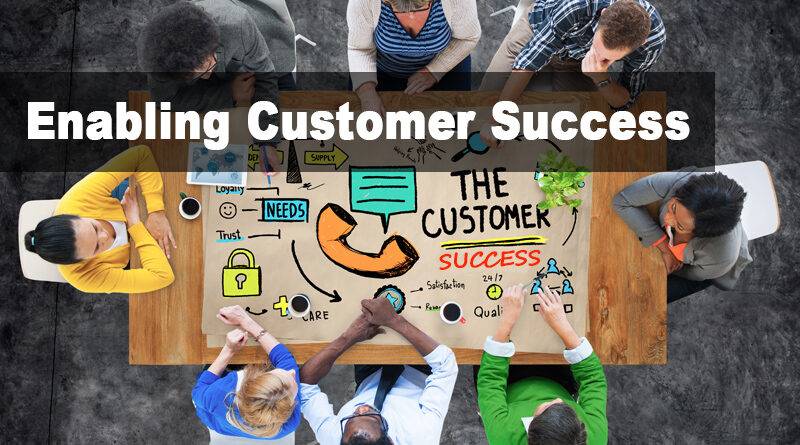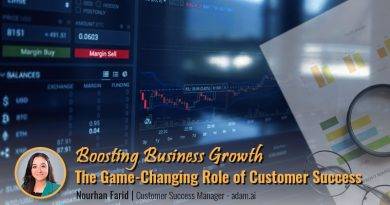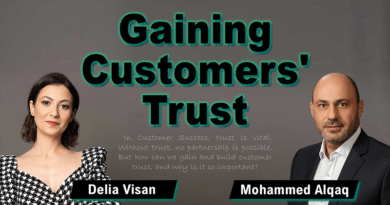Enabling Customer Success
Enabling Customer Success
By: Mohammed Alqaq
Customer success is the effort a business undertakes to help its customers be most successful, both with its product and in their own business operations.
It’s a proactive method of ensuring you’re meeting the needs of your customers to help them succeed with the help of your products and services. The goal is to reduce turnover to keep customers from choosing the competition instead.
According to HubSpot, “customer success provides proactive outreach aimed at increasing upsells and cross-sells, positive word-of-mouth, and successful outcomes for customers.”
Customers today have never had more options, and it’s never been easier for businesses to create new products and services. Because of this, there’s more pressure on companies, as sales and marketing aren’t always enough to sustain growth.
Regardless of your company size, there are so many things you can do to help your customer succeed.
Customer success is a company-wide goal
From sales and marketing to product and from senior management to everyone in the company, customer success should be a goal and a priority for every member of your team. it’s essential to emphasize helping customers succeed across the company.
There are many ways to ensure that customer success is a priority, but the best way is by educating your team on what customer success does and what value it can provide. Different teams will process data differently, so to ensure that you deliver your message in the most thinkable way, you need to speak the team’s common language.
For instance, if you are talking to the product team, you need to focus on customer health score and product usage expansion, while when talking with the sales team you should focus on retaining customers’ numbers and how much they are worth. Choosing the right metrics for the right audience is critical and essential.
Prioritization of customers and their needs must be the core of your company’s culture. To ensure that this happens, it must start early, from the very first day of your business.
As the saying goes, “The best time to start was yesterday — The second-best time is now”.
What success means to your customers
Many people talked about “success”, but what does it really mean?
According to Totango: “Customer success” refers to the way your business helps customers derive the most value possible from your products or services. It means prioritizing your customers’ satisfaction and ensuring they are always progressing toward their goals”.
It means being a trusted business partner who is here to discuss their needs and collaborate to find solutions to fit their specific process.
Effective teams let the customers tell them what success looks like. Success with your product or service will look like different things to different customers, so it’s essential to let their definitions lead. Many companies believe that the actions they want their customers to take are the ones they should base their metrics on.
To understand what success means to your customer, it’s essential to be an active listener, and understand what they are doing. Active Listening is one of the critical skills of a successful customer success manager.
Companies should grow success as defined by their customers, not as they expect it to be.
Companies should grow success as defined by their customers, not as they expect it to be.
Proactive customer engagement
According to Custify, “Proactive customer engagement means having a system in place to engage with customers throughout the customer journey in a proactive manner – before problems, needs, or changes arise. From onboarding to retention – all stages require some level of proactivity and it’s customer success’ job to do it.”
Proactive customer onboarding ensures those new customers get started on the right foot. That includes setting up the product to best suit their needs, learning how to use the features they need, and getting comfortable with using the product.
Extra guidance during the onboarding process can make a huge difference, it may not be practical for every company to offer high-touch customer success from the start. Instead, focus on how to get every new user and customer the same information in a consumable way.
The line between reactivity and proactivity is difficult to determine – especially when it comes to customer issues. Reaching out to the customer to solve an issue already reported is clearly reactive. However, the fact that you communicate with the customer prior to that issue becoming a support request or ticket can be considered proactive by CSMs and it is even part of the customer success regular workflow.
The difference is very subtle and subjective and trying to see if something is proactive or reactive is really not the point. What matters most is that you’re doing your best to help customers towards their goals.
Tracks and Assesses Customer Success
Customer success is highly data-driven. The metrics used within customer success can be very influential cross-functionally among teams.
A Customer Success Metric is a quantifiable measure that tracks and assesses the success of the CS team and is therefore an indicator of the customer’s success as they adopt and use the product.
Here are a few key customer success metrics worth monitoring:
- Customer Lifetime Value (CLV)
Customer lifetime value is the total worth to a business of a customer over the whole period of their relationship. It’s an important metric as it costs less to keep existing customers than it does to acquire new ones, so increasing the value of your existing customers is a great way to drive growth.
- Customer Retention Rate (CRR)
The customer retention rate measures the number of customers a company retains over a given period of time.
Your customer retention rate is the ratio between the number of customers you have kept during a given period and the total number of customers at the start of that period.
- Customer Retention Cost (CRC)
Customer retention cost is how much you spend to keep one customer buying from you for as long as possible. CRC is the cost of customer retention over a specific time.
- Churn Rate
The churn rate is the rate at which customers stop doing business with a company over a given period of time. Churn may also apply to the number of subscribers who cancel or don’t renew a subscription.
- Customer Health Score
The customer health score is a metric used to understand the likelihood of customers growing, staying consistent, or churning. Customer success leaders use it to predict how the business relationship with a customer can change over time.
Deciding on a scoring system is a subjective process and will vary from company to company. If you are looking for a starting point, here are a few metrics most organizations track:
- Overall product usage
- Depth and breadth of usage
- Account growth
- Number of renewals
- Number of upsells
- Length of customer engagement
- Need for support
- Survey results
- Product feedback
- Invoice history
- Community involvement
- Overall relationship
- Net Promoter Score (NPS)
Net Promoter Score®, or NPS®, measures customer experience and predicts business growth. This proven metric transformed the business world and now provides the core measurement for customer experience management programs the world around.
NPS is a widely used market research metric that is based on a single survey question asking respondents to rate the likelihood that they would recommend a company, product, or service to a friend or colleague.
- Customer satisfaction score (CSAT)
CSAT is short for customer satisfaction score. It’s a commonly used metric that acts as a key performance indicator for customer service and product quality in all kinds of businesses. While customer satisfaction as an idea is a general one, CSAT is a more defined metric that’s expressed as a percentage
CSAT is one of the most straightforward ways to measure customer satisfaction, and it’s obtained by asking a simple question, such as ‘How satisfied were you with your experience?’ To answer, there’s a corresponding survey scale, which can be 1 – 5, or 1 – 10.
- Customer effort score (CES)
Customer Effort Score (CES) is a type of customer satisfaction survey metric derived from a customer satisfaction survey that measures a product or service’s ease of use to customers. A Customer Effort Score reflects the amount of effort a customer had to exert to use a product or service, find the information they needed, or get an issue resolved.
It asks customers to rate the ease of using products or services on a scale of “very difficult” or “very easy.”
Customer Feedback
Customer feedback is the information, insights, issues, and input shared by your community about their experiences with your company, product, or services. This feedback guides improvements of the customer experience and can empower positive change in any business — even when it’s negative.
Before you begin collecting feedback from customers, you need to define why you’re seeking their input. Identifying your desired outcomes and outlining the process for getting there sets the groundwork for a worthwhile investment of your time, and your customers’ time. It is important because it serves as a guiding resource for the growth of your company.
Seeking customer feedback frequently and keeping a door open will ensure that, if something does go wrong or starts feeling bad, they’ll feel comfortable telling you. You should constantly be iterating and refining your strategy based on customer insights and feedback.
Creating a loop that continuously brings in honest customer feedback is the best way to keep up with those changes and ensure you can remain proactive for the long term.
Takeaway
With the increase of subscription-based business models (SaaS) and a broader emphasis on putting customers first, every company today can benefit from implementing a customer success program or empowering its program.
Customer success is the way forward to boost your customers’ experiences with your product, offer critical insights back to your internal teams, and streamline existing processes and make them more efficient.
A customer success team can have a significant impact on customer loyalty, churn, revenue, and so much more.




